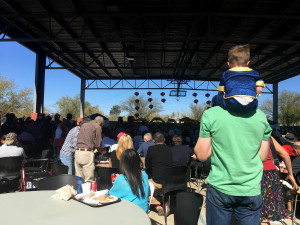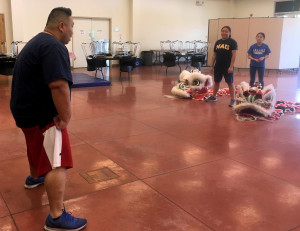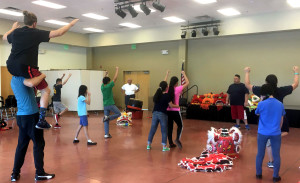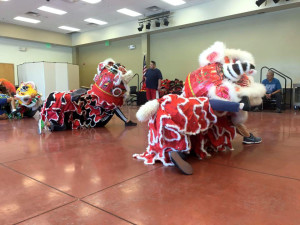
A dragon-like creature charges out from the side of the stage, his oversized red and yellow head sways back and forth to the beat of the drums.
At the bang of a gong, the creature’s giant eyelids flutter as they reveal bright green eyes peering at the audience. The mythical animal jumps off stage and its body maneuvers through the crowded aisles, occasionally stopping and twisting its head as the ears flap and mouth opens.
Underneath the costume are the legs of two people, the operators of the lifelike prop.
“I think the lion dance is the event everyone waits for,” says Susan Chan, the treasurer of the Tucson Chinese Culture Center and the woman in charge of the 2016 Chinese New Year celebration at the center.
Crowds came together at the celebration to watch the centuries-old dance.

“Is it real dad?” asks a little girl trying to get a better look by sitting atop her father’s shoulders.
The performance lasted 20 minutes before the lions paraded off stage, their tails waving back and forth in glee until they vanished behind the wall. People clapped and hoorayed, and after a few minutes wandered off.
Little did they know that behind the fence the performers were removing the heavy lion heads and cloth of the lion body that covered them, revealing smiles and excitement. The members jumped up and down and high-fived each other. The performance was a moment they had been training for for months.
“It’s not just dancing, it’s very heavy exercise orientated,” says Kevin Lau, a lion dance instructor at the TCCC. “It has strong cultural aspects but it also builds very close friendships.”
Two months after, the dancers return to the TCCC to begin to train for next year’s performance. The performers are not wearing their flowing frayed red pants that resemble the lions’ legs, but instead are in sweatpants, shorts, Nike shirts, white sneakers – whatever is most comfortable for them. The girls and boys in the class range from ages 12 to 21, some are under five feet tall and others rise over six feet. They stand in a straight line with their fists against their sides ready to start class.

The TCCC has been conducting lion dance classes for almost ten years now. There is a beginner’s class where participants can learn the basics and an advanced class. Kevin Lau leads the way as the members concentrate, ready to hear about todays schedule, beginning with warm-ups.
The lion dance is a traditional Chinese dance performed on special occasions such as grand openings, business openings, but is most popular during the Chinese New Year. Legend has it, Lau explains, that centuries ago a Chinese village was terrorized by evil spirits. The people prayed for something to protect them and down came the lion to chase away the demons and save the village. Today the lion dance is performed to bring good luck.
“Partner up. Make sure you know who is the head and who is the tail,” says Lau.
“The head takes lots of concentration,” says Gary Low, who learned the dance as a young boy in China. At the age of 82 he still participates in passing on his knowledge of the dance to kids at the TCCC.
Each lion prop is controlled by two people. “The ‘head’ has to lead, hold the 25 lb. head, open the mouth, bat the eyes, wiggle the ears. It is a lot to do at once! The tail is the support to the head. They also have to stay bent over the whole time,” says Low as he demonstrates by bending over so that his back is flat, a position he knows well since he usually played the tail.

The performers practice movements such as jumping forward in unison or shuffling back and forth, mastering it without the lion prop. Their strong stance is legs wide open, slightly squatting, a position commonly practiced in martial arts. The head performers jump forward and balance on one foot as they thrust their arms towards the ceiling. The tail performers stay bent over, their hands clutching the waist of their partner. Each face is focused as they concentrate on their balance and unity of the movement.
Once everyone perfects their moves the members run to the stage to grab one of the lion heads. Each lion has its own color and unique design. It is clear that pairs have a special attachment to certain ones. They grab the sleeping creatures putting the lion head over theirs and tossing the cloth over their back.
The lion’s mouth opens and the creature stands on fours.
Lau begins to count: “One. Two. Three.” The lions come to life.
“When people see the dance I want them to think they are actually watching mythical creatures that are alive,” Lau says. “I don’t want the audience to think ‘Oh it’s just two people under there.’ I want them to think of it as one being.”
“One, two, three. One, two, three.” The lions sway their heads zigzagging as they awake from their slumber. Their mouths occasionally open and a sliver of the face of the performer underneath is revealed as if the lion swallowed one of the dancers whole.

“You have to stand like this,” says Lau grabbing his stiff leg to show where the strength comes from. “Use your core. And tails, you should be supporting them so they don’t fall.” Everyone nods and they continue to practice.
Whether partners have been practicing with each other for ten years or only a few months, there tends to be moments of frustration underneath the five-foot cloth. “Ow! You stepped on my foot.” “Move!” “You’re too far back, I’m being pushed out.”
After persistence, teamwork and a few rounds the pairs master the moves. They remove the prop and high-five each other, excited about their accomplishments.
“Something I have seen come from the classes is friendships,” Lau says. “After class they will eat lunch with each other and just hang out. I think the kids will agree they made good friends from this experience.”
An hour later the performers stand in a line facing Lau as the class ends. They put their fists together and gently bow forward three times. The lion heads lay in the background resting, until the performers bring them to life again at the next class.

Lion Dance Classes at TCCC
“Our goal is to keep the tradition of the dance alive, teach others about the culture and to have fun,” says Kevin Lau, lion dance instructor. “Classes are open to anyone of any ethnicity or age.”
When: Beginners class is 10 to 11:30 a.m. Advanced class is 11:30 a.m. to 1 p.m.
Cost: $25 per semester
Location: Tucson Chinese Cultural Center, 1288 W. River Rd.
For more information, call (520) 292-6900 or visit TucsonChinese.org
Sara Cline is a reporter for El Independiente, a magazine produced by the School of Journalism at the University of Arizona. To contact her email [email protected]

